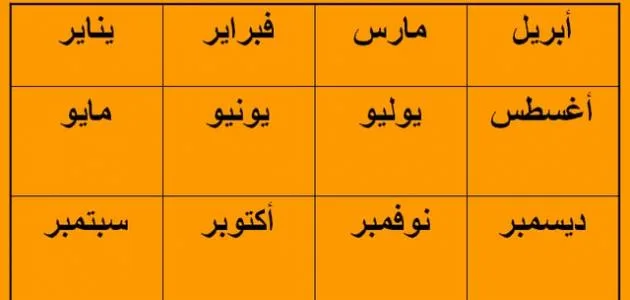اسماء الاشهر بالميلادي من أشهر السنة بالعربية واللغة الإنجليزية

اسماء الاشهر بالميلادي من أشهر السنة بالعربية واللغة الإنجليزية حيث سوف نتعرف على الأسماء باللغة العربية وكذلك الأسماء لشهور الميلادة بلغات اجنبية مثل اللغة الإنجليزية.
تعد الأشهر الميلادية جزءًا أساسيًا من تقويمنا اليومي، حيث يستخدمه معظم العالم لتحديد المواعيد والأحداث. يتكون التقويم الميلادي من 12 شهرًا، وكل شهر له اسمه وخصائصه الفريدة.
الأشهر الميلادية

- يناير (January):
- يبدأ السنة الميلادية الجديدة. في العديد من الثقافات، يعتبر بداية فترة جديدة للتخطيط والتنظيم.
- فبراير (February):
- يحتوي على 28 يومًا في السنة العادية و29 يومًا في السنة الكبيسة. يشتهر عيد الحب في هذا الشهر.
- مارس (March):
- يرمز لبدء الربيع في نصف الكرة الشمالي. يتضمن هذا الشهر الاحتفال ببدء الزراعة.
- أبريل (April):
- يعتبر شهر الأمطار، حيث يشهد العديد من المناطق زيادة في هطول الأمطار.
- مايو (May):
- يتميز بجو دافئ وجميل، ويعتبر وقتًا مثاليًا للاحتفالات في العديد من الثقافات.
- يونيو (June):
- يبدأ الصيف في نصف الكرة الشمالي، ويشتهر بالاحتفالات والمهرجانات.
- يوليو (July):
- يعتبر من أشهر الصيف، حيث يُحتفل بعيد الاستقلال في العديد من الدول.
- أغسطس (August):
- يُعد وقت الإجازات الصيفية والأنشطة في الهواء الطلق.
- سبتمبر (September):
- يعود الطلاب إلى المدارس، ويبدأ فصل الخريف في نصف الكرة الشمالي.
- أكتوبر (October):
- يشتهر بعيد الهالوين، حيث يحتفل الناس بارتداء الأزياء المختلفة.
- نوفمبر (November):
- يتم الاحتفال بعيد الشكر في بعض البلدان، ويبدأ التحضير لموسم الأعياد.
- ديسمبر (December):
- شهر الأعياد، حيث يحتفل الناس بعيد الميلاد ورأس السنة.
خلاصة
تسهم أسماء الأشهر الميلادية في تنظيم حياتنا اليومية وتحديد الأحداث المهمة. يجب أن نكون على دراية بهذه الأسماء والتواريخ، حيث تلعب دورًا كبيرًا في ثقافتنا ومجتمعاتنا.
English Version: Names of the Gregorian Months
Introduction
The Gregorian months are an essential part of our daily calendar, used by most of the world to determine dates and events. The Gregorian calendar consists of 12 months, each with its own name and unique characteristics.
Gregorian Months
- January:
- Marks the beginning of the new calendar year. In many cultures, it signifies a fresh start for planning and organization.
- February:
- Contains 28 days in a common year and 29 days in a leap year. Known for Valentine’s Day.
- March:
- Symbolizes the arrival of spring in the Northern Hemisphere, marking the start of the farming season.
- April:
- Recognized for its rains, many regions experience increased precipitation during this month.
- May:
- Known for its warm and pleasant weather, making it an ideal time for celebrations in various cultures.
- June:
- Begins summer in the Northern Hemisphere, famous for festivals and gatherings.
- July:
- One of the summer months, often associated with independence celebrations in many countries.
- August:
- Considered a time for summer vacations and outdoor activities.
- September:
- Marks the return of students to school and the beginning of autumn in the Northern Hemisphere.
- October:
- Famous for Halloween, where people celebrate by wearing various costumes.
- November:
- Celebrations like Thanksgiving occur in some countries, and preparations for the holiday season begin.
- December:
- The month of holidays, with celebrations for Christmas and New Year’s Eve.
Conclusion
The names of the Gregorian months play a significant role in organizing our daily lives and marking important events. Being aware of these names and dates is crucial, as they significantly impact our culture and societies.


